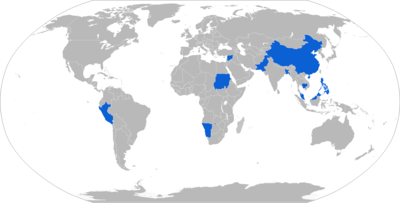FN-6
FN-6 or Feinu-6 (Chinese: 飞弩-6; pinyin: Fēi Nú-6; lit.: 'Flying Crossbow-6') is a third generation passive infrared homing (IR) man portable air defence system (MANPADS). It was developed by China, and is their most advanced surface-to-air missile offered in the international market. Specially designed to engage low flying targets, it has a range of 6 km and a maximum altitude of 3.8 km. The FN-6 is in service with the People's Liberation Army (PLA), and has also been exported to Malaysia, Cambodia, Sudan, Pakistan and Peru. Based on FN-6, China has developed a number of other MANPADS, such as HN and FY series, as well as other vehicle-based short-range air defense systems such as FN and FB series.
| FeiNu-6 (Hongying-6) | |
|---|---|
| Type | Man-portable surface-to-air missile |
| Place of origin | China |
| Service history | |
| Used by | See Operators |
| Wars |
|
| Production history | |
| Variants | See Variants |
| Specifications (FN-6) | |
| Mass | 16 kg |
| Length | 1495mm |
| Diameter | 72mm |
| Maximum firing range | 6,000 meters |
| Engine | Single Stage Solid Rocket Motor |
| Flight altitude | 3,800 meters |
| Maximum speed | 600m/s |
Guidance system | Infrared homing |
Development
The weapon was specifically designed to be used against targets flying at low and very low altitudes.[1] The FN-6 was developed in parallel with the Qian Wei (QW) missile series. FN-6, or FeiNu-6, is the export name given to the export version derived from this system, and it is known as HongYing-6 (Chinese: 红缨; pinyin: hóng yīng; lit.: 'red tassel') in the PLA.[2][3] The training simulator of FN-6 is not developed by the contractor of the missile system, but instead, the simulator is developed by PLA itself after the missile was purchased, and the general designer of the training simulator of FN-6 is Mr. Liu Weixing (刘卫星). The training simulator of FN-6 is also used for later versions of MANPADS developed from FN-6.
Export sales of the weapon is the responsibility of China National Precision Machinery Import and Export Corporation, a state owned trading company responsible for representing the domestic defense production industry in air defense related products.[4]
Characteristics
According to Janes, the FN-6 is a third generation, passive infrared,[1] man portable air defence system (MANPADS). It is equipped with a digital infrared seeker with a strong resistance to flares, solar heat and heat from the ground. The pyramid shaped nose of the missile houses the four unit infrared seeker. The handle of the launcher houses the batteries and cooling system. An IFF antenna and an optional clip-on optical sight are fitted on to the launcher.[1][3]
The missile is capable of all-aspect attack and has a 70% single shot hit probability. It can engage targets manoeuvring at up to 4 g.[1] When FN-6 MANPADS can be equipped with night vision equipment, and it can also be equipped with IFF systems, two of which were shown to public, one of which is similar in appearance to AN/PPX-1 IFF of FIM-92 Stinger, while the other IFF system is a fish bone configuration. When equipped with IFF system, the name is changed from FN-6 to FY-6, or short for Fei Ying, meaning Flying Eagle (飞鹰).
Specifications
The complete FN-6 missile system weighs 16 kg. The missile is 1.495 m in length, and has a diameter of 0.072 m. The weight of the missile is unknown. It uses a single stage solid rocket motor, and can obtain a maximum speed of 360 m/s when flying head-on, and 300 m/s when tail chasing. The missile's operating range is from 500 m to 6 km, and its operating altitude is from 15 m to 3.5 km.[3]
Variants
FN-16
At the 7th Zhuhai Airshow held at the end of 2008, China revealed a new addition to FN series MANPAD, FN-16. FN-16 is an improvement of earlier FN-6, with better all aspect attack capability and better resistance against electronic countermeasures. Another major improvement is in its seeker, which in addition to the original IR guidance, UV guidance is also incorporated, a practice adopted in the later version of FIM-92 Stinger. Like its predecessor FN-6, FN-16 can also be fitted with both IFF systems used on FN-6, and just like FN-6, FN-16 is re-designated as FY-16 (Fei Ying = 飞鹰, meaning Flying Eagle) when equipped with IFFs.
HN-6
HN-6 is a further development of FN/FY-6/16. The Chinese name for this missile is actually Hong Ying (红樱), meaning Red Tassel. However, HY, the Pinyin abbreviation of Hong Ying was already taken by the name of another Chinese missile family, the Silkworm series anti-shipping missile, whose Chinese name is Hai Ying (海鹰), meaning Sea Eagle. As a result, the designation of this follow-on of FN-6 MANPADS is changed to HN-6 to avoid confusion, following the earlier MANPADS HN-5. HN-6 utilizes fire control systems (FCS) of earlier FN/FY-6/16 MANPADS, but a new FCS sight of unknown designation has also been developed.[5]
In addition to improved performance over the original FN/FY-6/16 MANPADS, HN-6 incorporates a protective cap over the seeker of missile, offering better protection against the environmental elements.[6] Based on the photos and video clips of PLA training, this protective cap does not appear to be automatically ejected when the missile is fired, but instead, it is manually removed before firing the missile.[7] Another improvement of HN-6 over the earlier FN/FY-6/16 MANPADS is that it incorporates a fire station similar to that of RBS 70 and Mistral: a seat is attached to the light weight tripod firing stand that can be folded for transportation and storage, and the operator is protected by a bulletproof glass shield.[8]
FN-6A
FN-6A is the vehicle mounted version of FN-6 first revealed to public in 2005. The system is based on a Chinese HMMWVS, weighing 4.6 tons in total. A one-man turret is sandwiched between two quadruple launchers, and the electro-optical fire control systems (FCS) includes IR, laser and TV. Contrary to common arrangement on similar systems, the FCS of FN-6A is mounted in an unusual arrangement, namely under the launchers. Due to space limitations, the FCS is distributed among in between two places, one portion under one launcher and other portion in the opposite launcher across the turret. A 12.7 mm heavy machine gun is added for additional protection. The vehicle is operated by a two-man crew, one driver and one weapon system operator. Communication gear and land navigation gear are standard. The modular design of the system enables other subsystems to be incorporated easily, such as IFF. The auxiliary power unit provides enough power for the system to operate continuously for more than 8 hours.
The FCS of the FN-6A can lock on to a target 10 km away, and the reaction time is less than 5 seconds. Each vehicle can fight independently, but can be integrated with others to fight as a coherent unit by incorporating a command vehicle that is also based on an HMMWVS. The command vehicle provide a light solid state passive phased array radar to increase situation awareness, and can direct up to 8 launching vehicles simultaneously. A command vehicle and 8 launching vehicles form an air defense company when fighting as a coherent unit, and this in turn can be integrated into larger air defense networks. Alternatively, the launching vehicle can be directly integrated into larger air defense networks without the need of the command vehicle.
Each launching vehicle needs a support vehicle for resupply, and the support vehicle is also based on an HMMWVS to reduce logistic cost. Each supply vehicle carries 24 missiles and reloading each missile takes less than a minute. Similar to the M1097 Avenger, each launcher is designed so that each missile can also be removed and fired by a soldier manually like a regular MANPAD. Although effective against supersonic aircraft, for UAVs and missiles the maximum target speed is limited to 300 meters per second.
FB-6
FN-6A did not enter mass production and served only in very limited number in Chinese forces, mainly as trial purpose. In the subsequent Zhuhai Airshows followed its original debut, FN-6A is replaced by its successor FB-6A, which did see greater numbers in service with Chinese forces. The general designer of FB-6A system is Mr. Wei Zhigang (卫志刚), rumored also to be the general designer of FN-6A, the predecessor of FB-6A.[9] The main difference between FN-6A and its successor FB-6A is that the SAM system is broken down into two portions in the latter, as opposed to a single unit in the former: FB-6A SAM system consists of two vehicles, one carrying the engagement radar, while the other carrying the missile.[10][11] The search/engagement radar of FB-6A is planar array, and can be folded down in transit, but the developer has not revealed whether the radar itself is a phased array or not.[12] However, the developer did claim that both the mechanically scanned planar array and the electronically scanned passive phased array are both available upon customer's request, but it's not clear which one is in service with Chinese forces.
The missile launching platform of FB-6A differs from its predecessor in that both the 12.7 mm heavy machine (HMG) for self-protection and the electro-optical fire control sight on that of FN-6A are deleted, but a backup operator console is incorporated with bulletproof glass added between the launchers, though the FB-6A system can be operated with the vehicle. Although the 12.7 mm HMG is no longer the standard equipment of FB-6A system, it can be added as an option, and is interchangeable with other machine guns. The total numbers of missiles carried by the launching vehicle of FB-6A remain the same as FN-6A, still totaling eight.[13]
An upgraded version FB-6C, was unveiled at the 2016 Zhuhai Airshow.[14]
ZBL-09 ADS
At the 9th Zhuhai Airshow held in November 2012, one more variant of vehicle mounted FN-6/16 system is revealed to public. This air defense system (ADS) consists of a 30 mm Gatling gun turret with two missile containers/launchers for FN-16 at the each side, totaling four missiles. In comparison to earlier Chinese HUMVEE mounted FN-6A and FB-6A ADS, the ZBL-09 ADS is mounted on 8 x 8 ZBL-09 chassis, thus offering greater protection.[15][16] A phased array radar on the turret can be folded down in transit, as with earlier FB-6A ADS. However, ZBL-09 did not enter Chinese service en masse, only a very limited number were ordered for trial purpose. It is rumored because the 30 mm Gatling gun is derived from AK-630, and this 6-barreled gun would complicate the logistics and increases the cost, because other 30 mm Gatling guns that already in Chinese service such as LD-2000 are 7-barreled based on Type 730 CIWS. This has led some Chinese military enthusiasts claim that ZBL-09 would be used mainly for export and to have a significant order from Chinese forces, the 6-barreled gun would have to be replaced by a 7-barreled one, but at the 9th Zhuhai Airshow, there was no news of development yet.
Combat history
Syrian Civil War
The combat debut of the FN-6 came during the 2013 phase of the Syrian Civil War.[17] By March 2013, two Syrian Air Force Mil Mi-8 or Mi-17 were shot down.[18]
The New York Times reports that Qatar supplied the Syrian rebels, possibly through purchase from the Sudanese inventory, with the FN-6 and that several units have now fallen into the hands of ISIS. However, spray paint had been used to obscure serial numbers in an effort to impede tracking of the weapon's supply chain.[19]
The Global Times, a state owned newspaper, states that, though Chinese-made missiles have downed aircraft in the past, the Syrian war "is the first time such a success has been recorded on video." The news outlet further raises the possibility of this improving the sales and image of Chinese defense products abroad.[18] The newspaper further praised the reliability of the weapon asserting that "[t]he kills are proof that the FN-6 is reliable and user-friendly, because rebel fighters are generally not well trained in operating missile systems."[20] The New York Times, though claims that rebels have complained the missile's performance, such as failings to fire or lock on and two premature explosions while firing, which killed two rebels and wounded four more.[19]
On 18 August, the first recorded kill of a fixed-wing aircraft took place when a team from the Islamic Harakat Ahrar ash-Sham Al Islami brigade downed a SyAAF MiG-21 over Latakia province. The jet's pilot was filmed parachuting but his fate is not known. This downing is also the FN-6's first jet kill.[21]
ISIL in Iraq
In the aftermath of the 2014 ISIL offensive in Iraq, on 3 October, an FN-6 allegedly supplied by Qatar was used by the militant group to shoot down an Iraqi Army Mil Mi-35 attack helicopter near Baiji.[22] It also may have been used to destroy a Bell 407 scout helicopter in the same area on 8 October, killing both pilots.[23]
Operators





.svg.png)







Reference list
- "FN-6 (China), Man-portable surface-to-air missile systems". Jane's Information Group. Archived from the original on 5 December 2009. Retrieved 30 December 2008.
- Andrei Chang (28 March 2008). "China ships more advanced weapons to Sudan". UPI Asia. Archived from the original on 9 June 2012. Retrieved 30 December 2008.
- "HongYing-6 (FN-6) Man-Portable Surface-to-Air Missile". Sinodefence. 21 December 2007. Archived from the original on 10 May 2006. Retrieved 30 December 2008.
- The Chinese Army Today: Tradition and Transformation for the 21st Century. Routledge. 2012. p. 54.
- "HN-6 FCS sight". Archived from the original on 20 May 2013. Retrieved 2 January 2013.
- "HN-6". Archived from the original on 21 September 2013. Retrieved 2 January 2013.
- Hongying-6 Archived 21 September 2013 at the Wayback Machine
- "Hongying-6 SAM". Archived from the original on 13 April 2014. Retrieved 2 January 2013.
- "FB-6A designer". Archived from the original on 24 December 2013. Retrieved 18 November 2012.
- "FB-6A SAM". Archived from the original on 20 May 2013. Retrieved 18 November 2012.
- "FB-6A ADS". Archived from the original on 17 November 2012. Retrieved 18 November 2012.
- FB-6A Archived 20 May 2013 at the Wayback Machine
- "FB-6A Mobile SAM". Archived from the original on 28 September 2013. Retrieved 18 November 2012.
- "Archived copy". Archived from the original on 11 July 2018. Retrieved 10 November 2018.CS1 maint: archived copy as title (link)
- "ZBL-09". Archived from the original on 21 September 2013. Retrieved 18 November 2012.
- "ZBL-09 ADS". Archived from the original on 21 September 2013. Retrieved 18 November 2012.
- Chivers, C.J. (24 July 2013). "The Risky Missile Systems That Syria's Rebels Believe They Need". The New York Times. Archived from the original on 22 February 2014. Retrieved 30 August 2013.
- Agence France-Presse (14 March 2013). "Rebels use China missiles to shoot down Syrian army helicopters". South China Morning Post. Archived from the original on 29 August 2018. Retrieved 28 August 2018.
- Chivers, C. J.; Schmitt, Eric (12 August 2013). "Arms Shipments Seen From Sudan to Syria Rebels". The New York Times. Archived from the original on 29 September 2018. Retrieved 26 February 2017.
- "Chinese missiles steal spotlight after downing Syria army helicopters". Global Times. 13 March 2013. Archived from the original on 17 March 2013. Retrieved 13 August 2013.
- Binnie, Jeremy (18 August 2013). "Hardline Islamists down Syrian jet with Chinese MANPADS". janes.com. Archived from the original on 3 December 2013. Retrieved 22 November 2013.
- Gibbons-Neff, Thomas (10 October 2014). "Islamic State's shootdown of an Iraqi helicopter amplifies fears of shoulder-fired missiles". Washington Post. Archived from the original on 6 October 2018. Retrieved 28 August 2018.
- https://www.nytimes.com/glogin?URI=http%3A%2F%2Fwww.nytimes.com%2F2014%2F10%2F09%2Fworld%2Fmiddleeast%2Fisis-iraq-violence.html%3F_r%3D2
- "PM for maintaining mutual trust, fraternity in army". Newagebd.net. Archived from the original on 29 May 2015. Retrieved 29 May 2015.
- "Archived copy". Archived from the original on 4 September 2013. Retrieved 24 January 2010.CS1 maint: archived copy as title (link)
- "FN-6 Man-portable surface-to-air missile systems in PLAAF". Archived from the original on 9 October 2015. Retrieved 30 September 2015.
- Xu Tianran (13 March 2013). "Chinese missiles steal spotlight after downing Syria army helicopters Global Times". Global Times. Archived from the original on 17 March 2013. Retrieved 13 August 2013.
- C. J. Chivers; Eric Schmitt (12 August 2013). "Arms Shipments Seen From Sudan to Syria Rebels". The New York Times. Archived from the original on 13 August 2013. Retrieved 13 August 2013.
- "Malaysia to purchase Chinese missiles". Daily Express. 21 July 2004. Archived from the original on 3 August 2004. Retrieved 30 December 2008.
- Nick Leong (21 July 2004). "China offers to transfer missile technology". The Star. Archived from the original on 9 June 2012. Retrieved 30 December 2008.
- "Namibia operating FN-6 missiles". DefenceWeb. 30 August 2018. Archived from the original on 30 August 2018. Retrieved 2 September 2018.
- "Pakistan's MoDP reveals orders for MANPADSs and other weapon systems in 2017–18". Jane's 360. 8 October 2019. Retrieved 8 October 2019.
- "Perú: Adquisición de misiles MANPADS". Alejo Marchessini. Defensa.com. 27 July 2009. Archived from the original on 1 May 2018. Retrieved 11 September 2009.
- Joe Pappalardo (2 June 2008). "Inside the Global Black Market for Antiaircraft Missiles". Popular Mechanics. Archived from the original on 9 June 2012. Retrieved 30 December 2008.
- "Archived copy". Archived from the original on 23 January 2018. Retrieved 23 January 2018.CS1 maint: archived copy as title (link)
- Yuri Lyamin (21 December 2018). "And Chinese FN-6 MANPADS also was shjowed on parade in Qatar". twitter.com. Retrieved 28 December 2018.
External links
- Chinese FN-6 / FN-16 MANPADS
- FN-6 in Syrian war (Simplified Chinese)